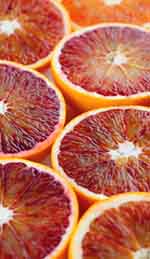 The blood orange is a varietal of the classic sweet orange, Citrus sinensis; the blood orange produces an even richer oil with a scent some have called “oranger than orange”! Both the dark red pigmentation and antioxidant properties of blood orange essential oil come from the presence of anthocyanins, antioxidant pigments normally found in dark berries and other purple or red fruits such as pomegranates [1].
The blood orange is a varietal of the classic sweet orange, Citrus sinensis; the blood orange produces an even richer oil with a scent some have called “oranger than orange”! Both the dark red pigmentation and antioxidant properties of blood orange essential oil come from the presence of anthocyanins, antioxidant pigments normally found in dark berries and other purple or red fruits such as pomegranates [1].
Blood oranges are now widely thought to be a mutation of the sweet orange. This is based on the discovery that all oranges have the gene to make anthocyanins, but only blood oranges have this gene activated [2]. Since at least the 18th century, blood oranges have been cultivated in Italy and China, and they’re now the main type of orange grown in Italy. In the U.S., both California and Texas grow blood oranges commercially. The anthocyanin pigmentation only develops when the oranges are grown in a Mediterranean climate where the nights get cold during the fall and winter months [2].
As with other citrus fruits, blood orange essential oil is extracted by cold pressing the rind of the fruit. Blood orange oil is mainly used as a mild anti-depressant and aphrodisiac [3]: its fresh, rich citrus scent elevates the mood and stabilizes the emotions, and may have a warming effect on the body.
Similar to bergamot oil in its uses and effects, the smell of blood orange oil can calm the nerves and ground the psyche; it also adds body to many citrus-based blends and perfumes. When using blood orange oil on the skin, be sure to wait 24 hours before sun exposure to avoid photosensitization [4].
Blood orange essential oil is unique among citrus oils for its concentration of anthocyanins, which otherwise don’t occur in citrus fruits. Due to its high acid content, blood orange oil can also be used as a household cleanser and antiseptic [5], but we imagine you’ll want to hoard every drop of this refreshing oil to buoy your spirits and reset your senses whenever you need a pick-me-up!
REFERENCES
1. “Blood Orange”. Wikipedia. Last modified April 27th, 2014. http://en.wikipedia.org/wiki/Blood_orange.
2. Butelli, E, C Licciardello, Y Zhang, J Liu, S Mackay, P Bailey, G Reforgiato-Recupero, and C Martin. 2012. “Retrotransposons control fruit-specific, cold-dependent accumulation of anthocyanins in blood oranges. The Plant Cell 10: 1-14.
3. Gupta, Chadra Sekhar. “Blood Orange Perfume Ingredient”. Fragrantica. Accessed June 19th, 2014. http://www.fragrantica.com/notes/Blood-Orange-286.html.
4. “Safety Information – Dermal Safety”. National Association for Holistic Aromatherapy. Accessed June 7th, 2014. http://www.naha.org/explore-aromatherapy/safety/#dermal.
5. Dabbah, Roger, VM Edwards, and WA Moats. January 1970. “Antimicrobial Action of Citrus Fruit Oils on Selected Food-Borne Bacteria”. Applied Microbiology 19 (1): 27-31.
